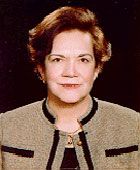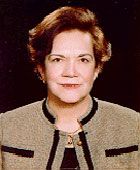(29 November 1926 – 13 September 2012)
She was an astronomer, specializing in astrophysics, who made major contributions to scientific research on the formation and evolution of the Sun, and other main sequence stars.
From 1961 to 1973, Dr. Eryurt held a position at NASA. She also established the Astrophysics Department in the Middle East Technical University(METU). She was the Dean of the METU Science and Literature Faculty from 1988 to 1993.
Eryurt was born on 29 November 1926 in İzmir, Turkey. Her father was Abidin Ege, who was a member of the Grand National Assembly of Turkey for Denizli Province in 1944.
Shortly after her father's arrival in İzmir, Eryurt's family moved to Istanbul, and then to Ankara a few years later. After completing her primary education in Ankara, she continued to Ankara Girls' High School. In high school she had a special interest in mathematics. For this reason, after graduating from high school, she enrolled in the Istanbul University Department of Mathematics and Astronomy. She pursued her interest in astronomy during her university studies.
After graduating from Istanbul University, in 1947, Eryurt worked as an honorary assistant for two years for Tevfik Oktay Kabakçıoğlu. She was assigned to open an Astronomy Department at Ankara University. She continued her graduate studies at the University of Michigan for a while, and in 1953 she completed her doctorate at the Ankara University Department of Astrophysics where she became Associate Professor.
In 1959, Eryurt went to Canada for two years with a scholarship from the International Atomic Energy Agency. Here she worked with Alastair G. W. Cameron. She then went to the USA and worked for the Soroptimist Federation of America at Indiana University, and on the identification of Stellar Models at the Goethe Link Observatory, working with Marshall Wrubel. After this experience, Eryurt worked at NASA's Goddard Institute for Space Studies. She collaborated with Alastair G. W. Cameron, on research on solar evolution. During this period, she was the only woman astronomer working at the institution.
Eryurt's work at the Goddard Institute revealed some facts about the Sun that were not understood until then. The existing theory that the brightness of the Sun was much lower at its formation, 4.5 billion years ago, was under scrutiny. It was revealed that the Sun was actually much brighter and warmer in the past and decreased to its current level. The studies were important at that time to influence the course of scientific and engineering research aims of new (for the time) space flights. She was awarded the Apollo Achievement Award in 1969 for her successful work contributing to the achievement of the Apollo 11 mission's first landing on the moon and
subsequent lunar exploration, by providing NASA engineers with crucial information for modelling solar impact on the lunar environment.
After completing her two year research study at the Goddard Institute, Eryurt continued to work at the institute as a Senior Researcher. The institute sent her to the University of California to work on a research study about the formation and development of main sequence stars.
In 1968, she came to Turkey and organized the first National Astronomy Congress with the support of the Scientific and Technological Research Council of Turkey (TÜBİTAK).
Between 1969 and 1973, Eryurt continued her scientific research work at NASA. In 1973 she returned to the Middle East Technical University Physics Department and founded the Astrophysics Branch. In 1977, she was awarded with the TÜBİTAK Science Award. In 1988, she was Chairperson of the Physics Department for six months, and then became the Dean of the Faculty of Science and Letters for five years. Eryurt retired in 1993, after a distinguished, accomplished and dedicated career in astrophysics.
Eryurt died in Ankara from a heart attack on 13 September 2012.
(29 November 1926 – 13 September 2012)
She was an astronomer, specializing in astrophysics, who made major contributions to scientific research on the formation and evolution of the Sun, and other main sequence stars.
From 1961 to 1973, Dr. Eryurt held a position at NASA. She also established the Astrophysics Department in the Middle East Technical University(METU). She was the Dean of the METU Science and Literature Faculty from 1988 to 1993.
Eryurt was born on 29 November 1926 in İzmir, Turkey. Her father was Abidin Ege, who was a member of the Grand National Assembly of Turkey for Denizli Province in 1944.
Shortly after her father's arrival in İzmir, Eryurt's family moved to Istanbul, and then to Ankara a few years later. After completing her primary education in Ankara, she continued to Ankara Girls' High School. In high school she had a special interest in mathematics. For this reason, after graduating from high school, she enrolled in the Istanbul University Department of Mathematics and Astronomy. She pursued her interest in astronomy during her university studies.
After graduating from Istanbul University, in 1947, Eryurt worked as an honorary assistant for two years for Tevfik Oktay Kabakçıoğlu. She was assigned to open an Astronomy Department at Ankara University. She continued her graduate studies at the University of Michigan for a while, and in 1953 she completed her doctorate at the Ankara University Department of Astrophysics where she became Associate Professor.
In 1959, Eryurt went to Canada for two years with a scholarship from the International Atomic Energy Agency. Here she worked with Alastair G. W. Cameron. She then went to the USA and worked for the Soroptimist Federation of America at Indiana University, and on the identification of Stellar Models at the Goethe Link Observatory, working with Marshall Wrubel. After this experience, Eryurt worked at NASA's Goddard Institute for Space Studies. She collaborated with Alastair G. W. Cameron, on research on solar evolution. During this period, she was the only woman astronomer working at the institution.
Eryurt's work at the Goddard Institute revealed some facts about the Sun that were not understood until then. The existing theory that the brightness of the Sun was much lower at its formation, 4.5 billion years ago, was under scrutiny. It was revealed that the Sun was actually much brighter and warmer in the past and decreased to its current level. The studies were important at that time to influence the course of scientific and engineering research aims of new (for the time) space flights. She was awarded the Apollo Achievement Award in 1969 for her successful work contributing to the achievement of the Apollo 11 mission's first landing on the moon and
subsequent lunar exploration, by providing NASA engineers with crucial information for modelling solar impact on the lunar environment.
After completing her two year research study at the Goddard Institute, Eryurt continued to work at the institute as a Senior Researcher. The institute sent her to the University of California to work on a research study about the formation and development of main sequence stars.
In 1968, she came to Turkey and organized the first National Astronomy Congress with the support of the Scientific and Technological Research Council of Turkey (TÜBİTAK).
Between 1969 and 1973, Eryurt continued her scientific research work at NASA. In 1973 she returned to the Middle East Technical University Physics Department and founded the Astrophysics Branch. In 1977, she was awarded with the TÜBİTAK Science Award. In 1988, she was Chairperson of the Physics Department for six months, and then became the Dean of the Faculty of Science and Letters for five years. Eryurt retired in 1993, after a distinguished, accomplished and dedicated career in astrophysics.
Eryurt died in Ankara from a heart attack on 13 September 2012.
Sponsored by Ancestry
Advertisement
Advertisement


